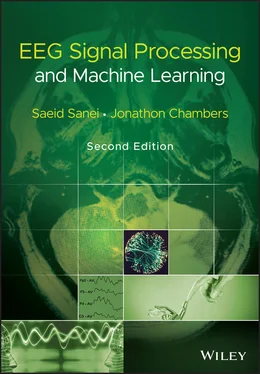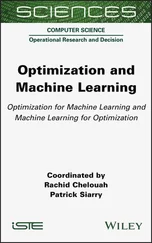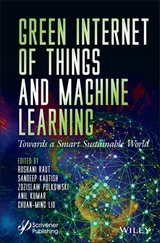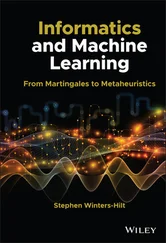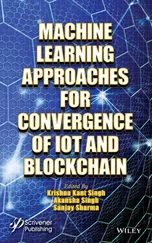Saeid Sanei - EEG Signal Processing and Machine Learning
Здесь есть возможность читать онлайн «Saeid Sanei - EEG Signal Processing and Machine Learning» — ознакомительный отрывок электронной книги совершенно бесплатно, а после прочтения отрывка купить полную версию. В некоторых случаях можно слушать аудио, скачать через торрент в формате fb2 и присутствует краткое содержание. Жанр: unrecognised, на английском языке. Описание произведения, (предисловие) а так же отзывы посетителей доступны на портале библиотеки ЛибКат.
- Название:EEG Signal Processing and Machine Learning
- Автор:
- Жанр:
- Год:неизвестен
- ISBN:нет данных
- Рейтинг книги:3 / 5. Голосов: 1
-
Избранное:Добавить в избранное
- Отзывы:
-
Ваша оценка:
- 60
- 1
- 2
- 3
- 4
- 5
EEG Signal Processing and Machine Learning: краткое содержание, описание и аннотация
Предлагаем к чтению аннотацию, описание, краткое содержание или предисловие (зависит от того, что написал сам автор книги «EEG Signal Processing and Machine Learning»). Если вы не нашли необходимую информацию о книге — напишите в комментариях, мы постараемся отыскать её.
EEG Signal Processing and Machine Learning — читать онлайн ознакомительный отрывок
Ниже представлен текст книги, разбитый по страницам. Система сохранения места последней прочитанной страницы, позволяет с удобством читать онлайн бесплатно книгу «EEG Signal Processing and Machine Learning», без необходимости каждый раз заново искать на чём Вы остановились. Поставьте закладку, и сможете в любой момент перейти на страницу, на которой закончили чтение.
Интервал:
Закладка:
27 27 Karlin, R., Weinapple, M., Rochford, J., and Goldstein, L. (1979). Quantitated EEG features of negative affective states: report of some hypnotic studies. Research Communications in Psychology, Psychiatry, and Behavior 4: 397–413.
28 28 Tucker, D.M., Stenslie, C.E., Roth, R.S., and Shearer, S.L. (1981). Right frontal lobe activation and right hemisphere performance decrement during a depressed mood. Archives of General Psychiatry 38 (2): 169–174.
29 29 Foster, P.S. and Harrison, D.W. The relationship between magnitudes of cerebral activation and intensity of emotional arousal. International Journal of Neuroscience 112: 1463–1477, 2002.
30 30 Foster, P.S. and Harrison, D.W. (2004). Cerebral correlates of varying ages of emotional memories. Cognitive and Behavioral Neurology 17 (2): 85–92.
31 31 Demaree, H.A., Everhart, D.E., Youngstrom, E.A., and Harrison, D.W. (2005). Brain lateralization of emotional processing: historical roots and a future incorporating dominance. Behavioral and Cognitive Neuroscience Reviews 4 (1): 3–20. https://doi.org/10.1177/1534582305276837.
32 32 Lee, G.P., Meador, K.J., Loring, D.W. et al. (2004). Neural substrates of emotion as revealed by functional magnetic resonance imaging. Cognitive and Behavioral Neurology 17 (1): 9–17.
33 33 Xu, X., Wei, F., Zhu, Z. et al. (2020). EEG feature selection using orthogonal regression: application to emotion recognition. ICASSP 2020–2020 IEEE International Conference on Acoustics, Speech and Signal Processing (ICASSP), 1239–1243. Barcelona, Spain. https://doi.org/10.1109/ICASSP40776.2020.9054457.
34 34 Zheng, W.‐L., Zhu, J.‐Y., and Lu, B.‐L. (2019). Identifying stable patterns over time for emotion recognition from EEG. IEEE Transactions on Affective Computing 10 (3): 417–429.
35 35 Costa, T., Rognoni, E., and Galati, D. (2006). EEG phase synchronization during emotional response to positive and negative film stimuli. Neuroscience Letters 406: 159–164.
36 36 Mullin, A.P., Gokhale, A., Moreno‐De‐Luca, A. et al. (2013). Neurodevelopmental disorders: mechanisms and boundary definitions from genomes, interactomes and proteomes. Translational Psychiatry 3: e329. https://doi.org/10.1038/tp.2013.108.
37 37 Sharbrough, F.W. (1999). Nonspecific abnormal EEG patterns, Chapter 12. In: Electroencephalography, Basic Principles, Clinical Applications, and Related Fields, 4e (eds. E. Niedermeyer and F.L. Da Silva). Lippincott Williams & Wilkins.
38 38 Bancaud, J., Hecaen, H., and Lairy, G.C. (1955). Modification de la reactivite E.E.G., troubles des functions symboliques et troubles con fusionels dans les lesions hemispherigues localisees. Electroencephalography and Clinical Neurophysiology 7: 179.
39 39 Westmoreland, B. and Klass, D. (1971). Asymetrical attention of alpha activity with arithmetical attention. Electroencephalography and Clinical Neurophysiology 31: 634–635.
40 40 Cobb, W. (1976). EEG interpretation in clinical medicine. In: Part B, Handbook of Electroencephalography and Clinical Neurophysiology, vol. 11 (ed. A. Remond), B1–B6. Elsevier.
41 41 Hess, R. (1975). Brain tumors and other space occupying processing. In: Part C, Handbook of Electroencephalography and Clinical Neurophysiology, vol. 14 (ed. A. Remond), C1–C6. Elsevier.
42 42 Klass, D. and Daly, D. (eds.) (1979). Current Practice of Clinical Electroencephalography, 1e. Raven Press.
43 43 Van Sweden, B., Wauquier, A., and Niedermeyer, E. (1999). Normal aging and transient cognitive disorders in the elderly, Chapter 18. In: Electroencephalography, Basic Principles, Clinical Applications, and Related Fields, 4e (eds. E. Niedermeyer and F.L. Da Silva), 340–348. Lippincott Williams & Wilkins.
44 44 America Psychiatric Association (1994). Committee on Nomenclature and Statistics, Diagnostic and Statistical Manual of Mental Disorder: DSM‐IV, 4e. Washington DC: American Psychiatric Association.
45 45 Brenner, R.P. (1999). EEG and dementia, Chapter 19. In: Electroencephalography, Basic Principles, Clinical Applications, and Related Fields, 4e (eds. E. Niedermeyer and F.L. Da Silva), 349–359. Lippincott Williams & Wilkins.
46 46 Neufeld, M.Y., Bluman, S., Aitkin, I. et al. (1994). EEG frequency analysis in demented and nondemented parkinsonian patients. Dementia 5: 23–28.
47 47 Niedermeyer, E. (1999). Abnormal EEG patterns: epileptic and paroxysmal, Chapter 13. In: Electroencephalography, Basic Principles, Clinical Applications, and Related Fields, 4e (eds. E. Niedermeyer and F.L. Da Silva), 235–260. Lippincott Williams & Wilkins.
48 48 Hughes, J.R. and Gruener, G.T. (1984). Small sharp spikes revisited: further data on this controversial pattern. Electroencephalography and Clinical Neurophysiology 15: 208–213.
49 49 Hecker, A., Kocher, R., Ladewig, D., and Scollo‐Lavizzari, G. Das Minature‐spike‐wave. Das EEG Labor 1: 51–56.
50 50 Geiger, L.R. and Harner, R.N. (1978). EEG patterns at the time of focal seizure onset. Archives of Neurology 35: 276–286.
51 51 Gastaut, H. and Broughton, R. (1972). Epileptic Seizure. Springfield, IL: Charles C. Thomas.
52 52 Oller‐Daurella, L. and Oller‐Ferrer‐Vidal, L. (1977). Atlas de Crisis Epilepticas. Geigy Division Farmaceut.
53 53 Niedermeyer, E. (1999). Nonepileptic attacks, Chapter 28. In: Electroencephalography, Basic Principles, Clinical Applications, and Related Fields, 4e (eds. E. Niedermeyer and F.L. Da Silva), 586–594. Lippincott Williams & Wilkins.
54 54 Creutzfeldt, H.G. (1968). Uber eine eigenartige herdformige erkrankung des zentralnervensystems. Zeitschrift für die gesamte Neurologie und Psychiatrie 57: 1–18, Quoted after W. R. Kirschbaum, 1920.
55 55 Jakob, A. (1968). Uber eigenartige erkrankung des zentralnervensystems mit bemerkenswerten anatomischen befunden (spastistische pseudosklerose, encephalomyelopathie mit disseminerten degenerationsbeschwerden). Deutsche Zeitschrift für Nervenheilkunde 70: 132, Quoted after W. R. Kirschbaum, 1921.
56 56 Niedermeyer, E. (1999). Epileptic seizure disorders, Chapter 27. In: Electroencephalography, Basic Principles, Clinical Applications, and Related Fields, 4e (eds. E. Niedermeyer and F.L. Da Silva), 476–585. Lippincott Williams & Wilkins.
57 57 Small, J.G. (1999). Psychiatric disorders and EEG, Chapter 30. In: Electroencephalography, Basic Principles, Clinical Applications, and Related Fields, 4e (eds. E. Niedermeyer and F.L. Da Silva), 235–260. Lippincott Williams & Wilkins.
58 58 Marosi, E., Harmony, T., Sanchez, L. et al. (1992). Maturation of the coherence of EEG activity in normal and learning disabled children. Electroencephalography and Clinical Neurophysiology 83: 350–357.
59 59 Linden, M., Habib, T., and Radojevic, V. (1996). A controlled study of the effects of EEG biofeedback on cognition and behavior of children with attention deficit disorder and learning disabilities. Biofeedback and Self‐Regulation 21 (1): 35–49.
60 60 Hermens, D.F., Soei, E.X., Clarke, S.D. et al. (2005). Resting EEG theta activity predicts cognitive performance in attention‐deficit hyperactivity disorder. Pediatric Neurology 32 (4): 248–256.
61 61 Swartwood, J.N., Swartwood, M.O., Lubar, J.F., and Timmermann, D.L. (2003). EEG differences in ADHD‐combined type during baseline and cognitive tasks. Pediatric Neurology 28 (3): 199–204.
62 62 Clarke, A.R., Barry, R.J., McCarthy, R., and Selikowitz, M. (2002). EEG analysis of children with attention‐deficit/hyperactivity disorder and comorbid reading disabilities. Journal of Learning Disabilities 35 (3): 276–285.
63 63 Yordanova, J., Heinrich, H., Kolev, V., and Rothenberger, A. (2006). Increased event‐related theta activity as a psychophysiological marker of comorbidity in children with tics and attention‐deficit/hyperactivity disorders. NeuroImage 32 (2): 940–955.
Читать дальшеИнтервал:
Закладка:
Похожие книги на «EEG Signal Processing and Machine Learning»
Представляем Вашему вниманию похожие книги на «EEG Signal Processing and Machine Learning» списком для выбора. Мы отобрали схожую по названию и смыслу литературу в надежде предоставить читателям больше вариантов отыскать новые, интересные, ещё непрочитанные произведения.
Обсуждение, отзывы о книге «EEG Signal Processing and Machine Learning» и просто собственные мнения читателей. Оставьте ваши комментарии, напишите, что Вы думаете о произведении, его смысле или главных героях. Укажите что конкретно понравилось, а что нет, и почему Вы так считаете.
